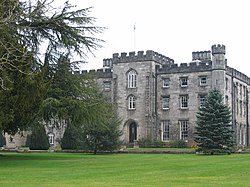Tulliallan Castle
| Tulliallan Castle | |
|
Perthshire | |
|---|---|
 Tulliallan Castle | |
| Type: | Country house |
| Location | |
| Grid reference: | NS935882 |
| Location: | 56°4’29"N, 3°42’45"W |
| History | |
| Information | |
| Owned by: | Police Scotland |
Tulliallan Castle is a large house in the parish of Tulliallan, in a detached part of Perthshire locally situate in Fife.
It is the second structure to have the name, and is a mixture of Gothic and Italian style architecture set amid some 90 acres of parkland just north of where the Kincardine Bridge spans the Firth of Forth. It has been the home of the Scottish Police College since 1954.
It was built in 1812-1820 for George Keith Elphinstone, Admiral Lord Keith one time senior officer of Lord Nelson, from money received from prize ships, by a labour force said to include French prisoners of war. During the Second World War its history took on a further international dimension when it was used by the Polish Armed Forces in the West as their headquarters.
Prior to the Second World War there was no central training for police officers in Scotland. After the war it was decided to centralise all police training and Tulliallan was the result.
Tulliallan, from the Gaelic Tulach-Aluin ('beautiful knoll') was purchased in 1950 by the then Scottish Home Department for £9,100. The building was modernised and renovated and the first courses for inspectors and sergeants began in 1954.
Over the years the site has been heavily modified to provide accommodation, catering, training and teaching facilities for the Scottish Police College.
The building is now used as the administrative head of the Scottish Police College and also provides the accommodation for the Director of the College.
An earlier structure about a half mile Northwest, Old Tulliallan Castle, was built by 1304, when it was ordered to be strengthened by Edward I of England, it then passed into the ownership of William Douglas, 1st Earl of Douglas, and was granted by the Douglases to the Edmonstones and thence to a junior branch of the Blackadders, and finally to the Bruces of Carnock. A fortified house with a keep and rib-vaulted ground floor, it was abandoned in the seventeenth century.